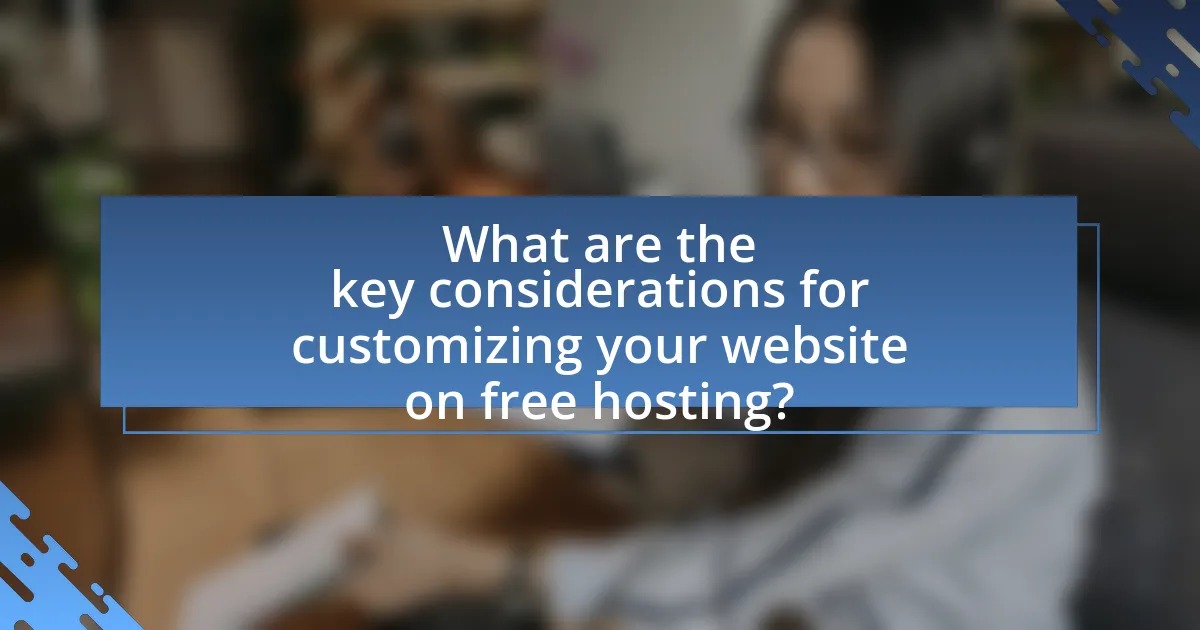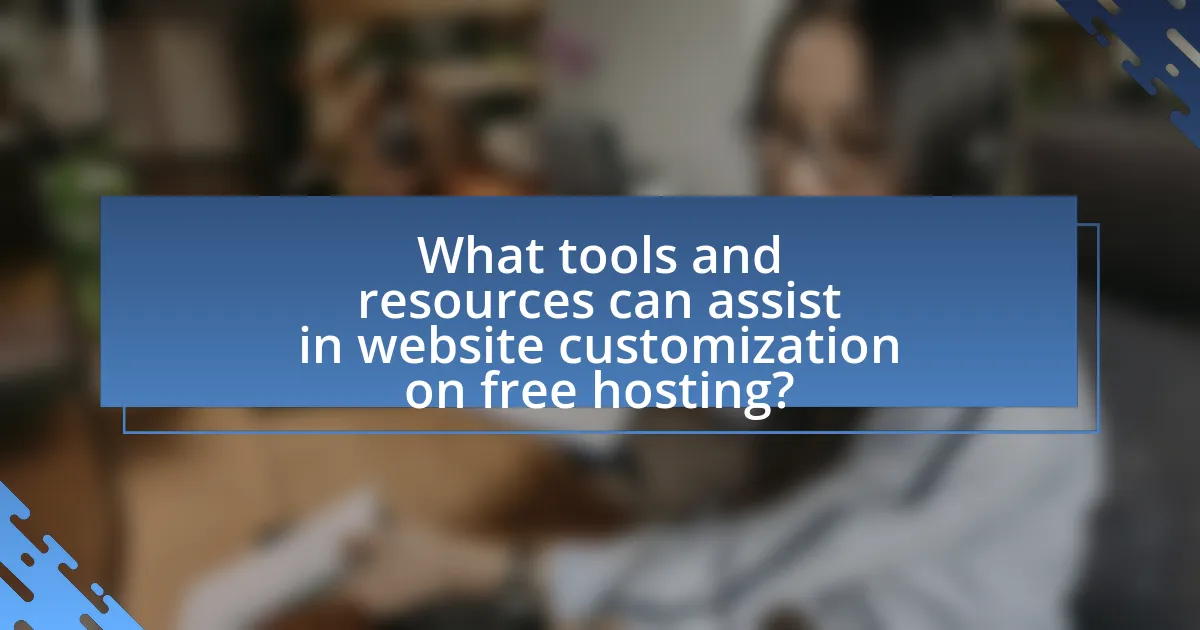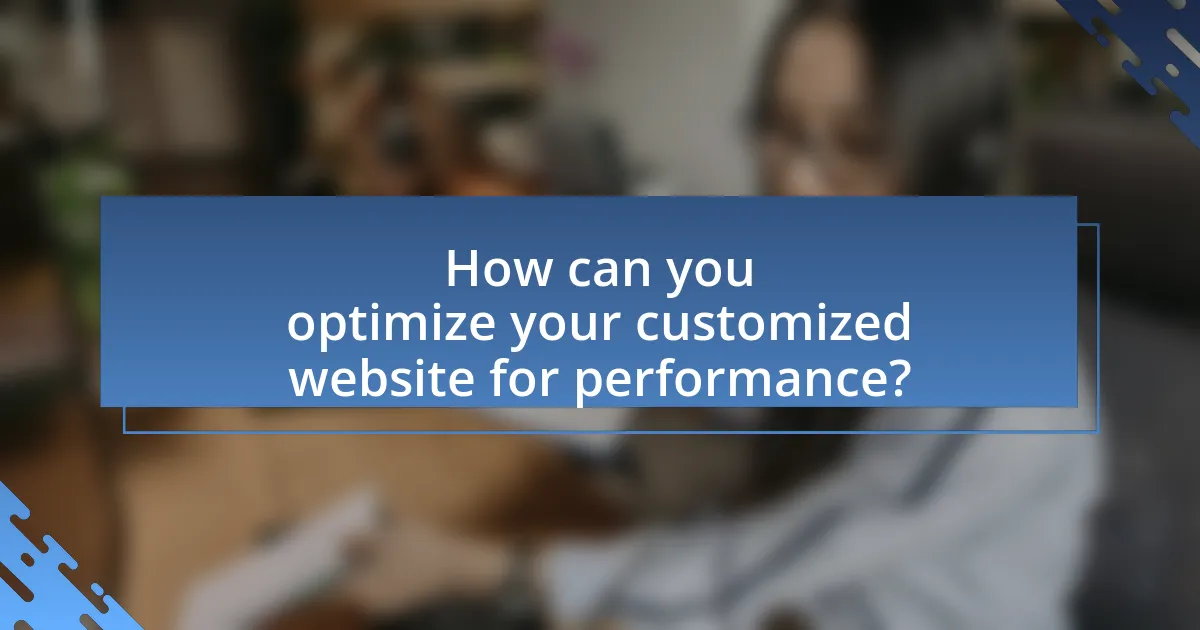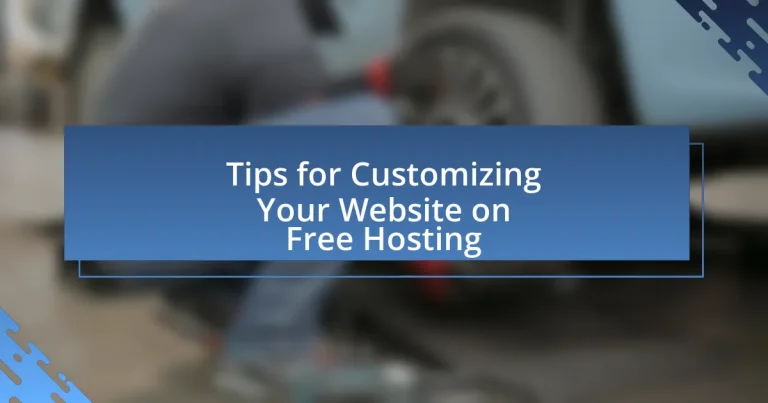The article focuses on tips for customizing websites hosted on free platforms, highlighting key considerations such as limitations on storage, bandwidth, and customer support. It discusses how free hosting impacts customization options, including restrictions on themes, plugins, and coding capabilities. The article also outlines essential elements for personalization, strategies to work around limitations, and tools that can enhance functionality. Additionally, it emphasizes best practices for maintaining a customized website, including regular updates and performance optimization techniques.

What are the key considerations for customizing your website on free hosting?
The key considerations for customizing your website on free hosting include limitations on storage and bandwidth, lack of customer support, and potential branding restrictions. Free hosting services often impose storage limits, which can restrict the amount of content you can upload, and bandwidth caps that may affect site performance during high traffic. Additionally, many free hosting platforms do not provide customer support, making it difficult to resolve issues quickly. Furthermore, free hosting may require you to display their branding on your site, which can detract from your brand identity. These factors are critical to assess to ensure your website meets your needs effectively.
How does free hosting impact website customization options?
Free hosting significantly limits website customization options. Users often face restrictions on features such as access to custom themes, plugins, and coding capabilities, which are essential for tailoring a website to specific needs. For instance, many free hosting services impose templates that cannot be altered beyond basic settings, preventing unique branding and functionality. Additionally, the lack of support for advanced coding languages like PHP or JavaScript further constrains the ability to implement custom features. These limitations are evident in platforms like WordPress.com, where free users cannot install third-party plugins, thereby restricting the site’s functionality and design flexibility.
What limitations do free hosting services impose on customization?
Free hosting services impose significant limitations on customization, primarily restricting users from modifying server-side code and limiting access to advanced features. These services often provide a predefined set of templates and themes, which can hinder unique design implementations. Additionally, users may face restrictions on the use of custom plugins or third-party integrations, further constraining functionality. For instance, many free hosting platforms do not allow the installation of custom scripts or databases, which are essential for personalized web applications. These limitations are designed to maintain server stability and security but significantly reduce the flexibility needed for tailored website development.
How can you work around these limitations effectively?
To work around the limitations of free hosting effectively, utilize alternative platforms or tools that enhance functionality. For instance, consider using a content management system (CMS) like WordPress, which offers extensive customization options and plugins that can compensate for the restrictions of free hosting services. Additionally, leveraging external services for features such as forms, analytics, or e-commerce can provide enhanced capabilities without relying solely on the hosting provider. Research indicates that over 40% of websites use WordPress, showcasing its effectiveness in overcoming hosting limitations.
What are the essential elements to customize on your website?
The essential elements to customize on your website include the layout, color scheme, typography, images, and content. Customizing the layout allows for a user-friendly navigation experience, while a cohesive color scheme enhances brand identity. Typography affects readability and user engagement, and selecting appropriate images can significantly impact visual appeal. Finally, tailoring content to your target audience ensures relevance and improves user interaction. These elements collectively contribute to a professional and effective online presence.
How can you personalize your website’s design and layout?
To personalize your website’s design and layout, utilize customizable templates and themes available on your hosting platform. Many free hosting services offer a variety of templates that allow users to modify colors, fonts, and layouts to reflect their brand identity. For instance, platforms like WordPress and Wix provide drag-and-drop features that enable easy adjustments without coding knowledge. Additionally, incorporating personal images and logos can enhance the uniqueness of the site. Research indicates that personalized web design can increase user engagement by up to 50%, demonstrating the effectiveness of tailored layouts in attracting and retaining visitors.
What content should you focus on customizing for better engagement?
To enhance engagement, focus on customizing user experience content, including personalized recommendations, dynamic call-to-action buttons, and tailored landing pages. Personalized recommendations can increase conversion rates by up to 300%, as shown by a study from McKinsey, which highlights that personalization drives customer loyalty and satisfaction. Dynamic call-to-action buttons that adapt based on user behavior can significantly improve click-through rates, while tailored landing pages that reflect user interests lead to higher engagement levels. These strategies collectively create a more relevant and engaging experience for users on your website.

What tools and resources can assist in website customization on free hosting?
Website customization on free hosting can be effectively assisted by tools such as WordPress, Wix, and Weebly, which offer user-friendly interfaces and customizable templates. These platforms provide a range of features, including drag-and-drop editors, plugins, and themes that enhance design flexibility. For instance, WordPress powers over 40% of all websites and offers thousands of plugins for added functionality, making it a robust choice for customization. Additionally, resources like GitHub provide access to open-source code and community support, enabling users to modify their websites further. These tools and resources collectively empower users to create personalized websites even on free hosting platforms.
Which website builders are best for free hosting customization?
Wix and WordPress.com are the best website builders for free hosting customization. Wix offers a user-friendly drag-and-drop interface, allowing extensive design flexibility with customizable templates and various apps for added functionality. WordPress.com provides a robust platform with numerous themes and plugins, enabling users to tailor their sites significantly, even on the free plan. Both platforms have large communities and extensive documentation, supporting users in maximizing their customization options.
What features should you look for in a website builder?
When selecting a website builder, prioritize features such as ease of use, customization options, responsive design, SEO tools, and customer support. Ease of use ensures that users can create and manage their websites without extensive technical knowledge, which is crucial for those utilizing free hosting services. Customization options allow users to tailor their sites to specific needs and branding, enhancing user experience. Responsive design is essential as it ensures that websites function well on various devices, which is increasingly important given that over 50% of web traffic comes from mobile devices. SEO tools help improve visibility in search engines, making it easier for potential visitors to find the site. Lastly, reliable customer support is vital for troubleshooting and assistance, especially for users who may encounter challenges while using free hosting platforms.
How do different website builders compare in terms of customization?
Different website builders vary significantly in terms of customization capabilities. For instance, WordPress offers extensive customization options through thousands of themes and plugins, allowing users to modify almost every aspect of their site. In contrast, Wix provides a more user-friendly drag-and-drop interface but limits customization to its predefined templates, making it less flexible than WordPress. Squarespace strikes a balance with visually appealing templates and some customization options, but it still does not match the depth of WordPress. Shopify, primarily focused on e-commerce, offers customization mainly related to online store functionalities, which may not cater to general website needs. These differences highlight that while WordPress is the most customizable, other builders like Wix and Squarespace offer varying degrees of ease and flexibility, catering to different user preferences and technical skills.
What plugins or add-ons can enhance your website’s functionality?
Plugins and add-ons that can enhance your website’s functionality include SEO tools, social media integration, analytics, and security plugins. SEO tools like Yoast SEO help optimize content for search engines, improving visibility. Social media integration plugins, such as Social Snap, allow seamless sharing of content across platforms, increasing engagement. Analytics plugins like Google Analytics Dashboard for WP provide insights into visitor behavior, enabling data-driven decisions. Security plugins, such as Wordfence, protect against threats, ensuring website safety. These tools collectively improve user experience, increase traffic, and enhance overall site performance.
How can you find compatible plugins for your free hosting platform?
To find compatible plugins for your free hosting platform, start by checking the platform’s official documentation or support forums for a list of recommended plugins. Many free hosting services provide specific guidelines or a curated selection of plugins that are known to work seamlessly with their infrastructure. Additionally, you can search plugin repositories, such as WordPress.org, filtering by compatibility with your hosting environment. This ensures that the plugins you choose are optimized for performance and functionality on your specific platform.
What are the best plugins for improving user experience?
The best plugins for improving user experience include Yoast SEO, WPForms, and Elementor. Yoast SEO enhances website visibility and usability by optimizing content for search engines, which can lead to increased traffic and engagement. WPForms simplifies the process of creating user-friendly forms, making it easier for visitors to interact with the site. Elementor provides a drag-and-drop interface for designing responsive layouts, allowing users to create visually appealing pages without coding knowledge. These plugins are widely recognized for their effectiveness in enhancing user experience on websites.

How can you optimize your customized website for performance?
To optimize your customized website for performance, focus on minimizing load times and enhancing user experience. Implement techniques such as image compression, which can reduce file sizes by up to 70% without significant loss of quality, thereby speeding up page loading. Utilize browser caching to store frequently accessed resources, which can decrease load times by 50% for returning visitors. Additionally, leverage Content Delivery Networks (CDNs) to distribute content globally, reducing latency and improving access speed. Optimize your code by minifying CSS and JavaScript files, which can lead to faster parsing and execution times. According to Google, optimizing these elements can improve your website’s performance score significantly, leading to better search engine rankings and user retention.
What strategies can improve loading speed on a free hosting site?
To improve loading speed on a free hosting site, optimizing images is essential. Large image files can significantly slow down page loading times, so using compressed formats like JPEG or PNG and reducing dimensions can enhance performance. Additionally, leveraging browser caching allows frequently accessed resources to be stored locally, reducing load times for returning visitors. Implementing a Content Delivery Network (CDN) can also distribute content across multiple servers, decreasing latency. According to Google, optimizing images can reduce page load time by up to 80%, demonstrating the effectiveness of these strategies.
How does image optimization contribute to faster loading times?
Image optimization contributes to faster loading times by reducing the file size of images without significantly compromising quality. When images are optimized, they consume less bandwidth and load more quickly, which is crucial for user experience and search engine ranking. For instance, studies show that optimized images can reduce loading times by up to 80%, leading to lower bounce rates and higher engagement. This efficiency is achieved through techniques such as compression, resizing, and using appropriate file formats, which collectively enhance website performance on free hosting platforms.
What role does code minification play in website performance?
Code minification significantly enhances website performance by reducing the size of CSS, JavaScript, and HTML files. This reduction in file size leads to faster loading times, as smaller files require less bandwidth and can be transmitted more quickly over the internet. For instance, studies have shown that minifying code can decrease file sizes by up to 50%, which directly correlates with improved page load speeds and better user experience. Additionally, faster loading times can positively impact search engine rankings, as search engines prioritize sites that load quickly.
How can you ensure your website is mobile-friendly?
To ensure your website is mobile-friendly, implement a responsive design that adapts to various screen sizes. Responsive design uses flexible grids and layouts, allowing content to adjust seamlessly across devices. According to Google, 61% of users are unlikely to return to a mobile site they had trouble accessing, emphasizing the importance of mobile optimization. Additionally, utilizing tools like Google’s Mobile-Friendly Test can help identify issues and provide recommendations for improvement.
What tools can help you test mobile responsiveness?
Tools that can help you test mobile responsiveness include Google Mobile-Friendly Test, BrowserStack, and Responsinator. Google Mobile-Friendly Test evaluates how easily a visitor can use your page on a mobile device, providing insights on mobile usability. BrowserStack allows users to test websites across various devices and browsers in real-time, ensuring compatibility and responsiveness. Responsinator displays how a website looks on different screen sizes, helping developers identify layout issues. These tools are widely recognized in the industry for their effectiveness in assessing mobile responsiveness.
How can you adjust your design for better mobile usability?
To adjust your design for better mobile usability, implement a responsive design that adapts to various screen sizes. Responsive design ensures that elements such as text, images, and navigation adjust fluidly, providing an optimal viewing experience across devices. According to a study by Google, 61% of users are unlikely to return to a mobile site they had trouble accessing, highlighting the importance of mobile-friendly design. Additionally, using larger touch targets and simplifying navigation can enhance user interaction, as mobile users often rely on touch rather than a mouse.
What are the best practices for maintaining your customized website?
The best practices for maintaining your customized website include regular updates, consistent backups, performance monitoring, and security checks. Regular updates ensure that the website’s software, plugins, and themes are current, which helps prevent vulnerabilities; for instance, outdated software can be exploited by hackers. Consistent backups protect against data loss, allowing for quick recovery in case of issues; a study by the University of Maryland found that 30,000 websites are hacked daily, emphasizing the need for backups. Performance monitoring, through tools like Google PageSpeed Insights, helps identify and resolve issues that may slow down the site, as slow-loading pages can lead to higher bounce rates. Lastly, conducting regular security checks, including scanning for malware and ensuring SSL certificates are up to date, is crucial for maintaining user trust and data integrity.
How often should you update your content and design?
You should update your content and design at least every six months. Regular updates ensure that your website remains relevant, engaging, and aligned with current trends. Research indicates that websites with fresh content can improve search engine rankings and user engagement, as search engines favor updated information. Additionally, a study by HubSpot found that companies that blog regularly receive 97% more links to their websites, highlighting the importance of consistent content updates.
What common troubleshooting tips should you follow for free hosting issues?
To troubleshoot free hosting issues, first check your internet connection to ensure it is stable and functioning. Next, verify that your domain name is correctly pointed to the hosting server, as misconfigured DNS settings can lead to accessibility problems. Additionally, inspect your website’s files for any errors or missing components, as these can cause loading issues. Clear your browser cache to eliminate any stored data that may interfere with site loading. If problems persist, consult the hosting provider’s support documentation or contact their customer service for assistance, as they can provide specific guidance based on their platform. These steps are essential for resolving common issues encountered with free hosting services.


